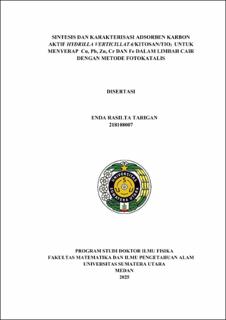| dc.description.abstract | Environmental pollution by heavy metals is a serious problem that requires effective solutions. One promising method is the adsorption method using biomass-based activated carbon. Hydrilla verticillata-activated carbon was carbonized at 300°C for 1 hour, chemically activated using HCl and NaOH, and then hydrothermally treated at 260°C for 12 hours in order to reduce the particle size of Hydrilla verticillata-activated carbon. Hydrilla verticillata activated carbon adsorbent was successfully synthesized and showed an increase in functional properties and the percentage of absorption and adsorption capacity against heavy metals with the percentage of absorption of heavy metals Pb 94.61%, Fe 79.23%, Cr 69.68%, Zn 29.90% and Cu 56.14%. This study also aims to develop activated carbon adsorbents from Hydrilla verticillata added with chitosan and TiO₂ to absorb heavy metals Fe, Cu, Pb, Zn, and Cr in liquid waste using the photocatalyst method. The synthesis of Hydrilla verticillata-activated carbon added with chitosan and TiO₂ was carried out by the hydrothermal method. The composition of Hydrilla verticillata activated carbon is 80%, chitosan 5%, and TiO₂ 15%. The adsorbent test of Hydrilla verticillata/chitosan/TiO₂ activated carbon with heavy metal solutions of Fe, Cr, Zn, Cu, and Pb was carried out using the photocatalyst method with UV irradiation, the variation of irradiation time used was 30, 60, 90, 120, and 150 minutes. The test results using AAS showed that the percentage of heavy metal absorption at an irradiation time of 150 minutes was Fe 97.46%, Cr 78.05%, Zn 99.97%, Cu 85.76%, and Pb 99.97%. Characterization was carried out using SEM/EDX, XRD, FTIR, BET/BJH, PSA, and AAS. The XRD results showed that Hydrilla verticillata-activated carbon has a semi-crystalline structure with a dominant amorphous phase, which is beneficial for heavy metal adsorption. The PSA test showed that the particle size of Hydrilla verticillata activated carbon was 4.480 μm, chitosan 0.196 μm, and TiO₂ 0.285 μm. The surface morphology of Hydrilla verticillata activated carbon adsorbent added with chitosan, and TiO₂ showed pores, a rough surface, less homogeneous, and the formation of agglomeration. The surface area of the adsorbent was 51,632 m²/g, pore volume 0.0616 cc/g, and pore radius 2.38608 nm. Based on the pore radius value, the Hydrilla verticillata/chitosan/TiO₂ carbon adsorbent was broken down into mesopores. This study proves that Hydrilla verticillata/chitosan/TiO₂ activated carbon can be a potential adsorbent for heavy metal waste treatment, with a combination of photocatalyst methods that increase adsorption efficiency. | en_US |


